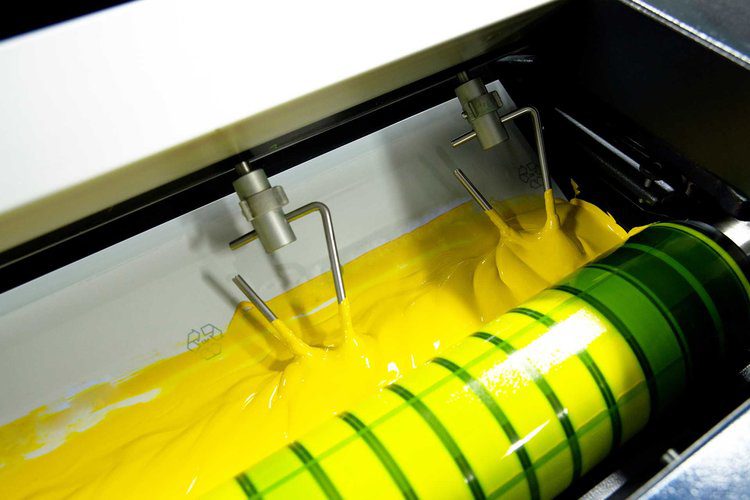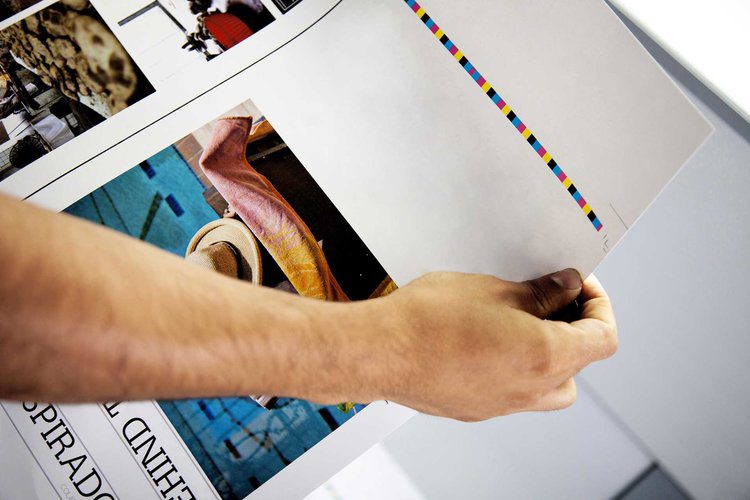Following our rundown of the essential graphic design terminology that will help you to better describe what you want, we’re taking a look at sprint-specific terms. Whether you’re printing flyers, hardback books or catalogues, knowing what you’re talking about will help you to ask for the right things from your print company. Here are some of the most common printing terms that you should know.
Binding
Binding is how the pages of a book or brochure are held together. There are many choices, which are suitable for different numbers of pages or particular aesthetics. Common types of binding include saddle stitched, perfect bound and hardcover (also called case bound). Take a look at this great resource for some visualisations.
Bleed
Bleed is a buffer to allow for movement during the printing and cutting process by extending the design past the crop marks. In most cases, printers require a 3mm bleed around the edge of each page to prevent white lines around the edges. This means printing on a larger size of paper than the required end result, as the sheets will be trimmed.
CMYK
While digital design uses RGB color (Red, green, blue), CMYK (Cyan, magenta, yellow, black) is preferred for print media. Traditional lithographic printing presses use individual plates of each of these four colours to create the final shade. If you use Pantone or spot colours, you should bear in mind that there may not be an exact CMYK colour match for litho printing.
Crop or trim marks
These are lines printed in the corner of each page to show the printer where to cut the paper for the finished size. They usually cut through the bleed to ensure proper printing of the design.

Die-cut
This process is often used when you require a specific shape to be cut out of your printed sheet. You might want patterns or letterwork cut from the centre of the page, a shaped outline, or any number of creative options. The process is done by moulding a metal cutter (die) for the desired shape, so it can be costly if you require something bespoke.

Embossing and debossing
Embossing is the creation of a raised design by pressing a die into the paper. Debossing follows the same principle as embossing, but the design is recessed rather than raised.
Foiling
Foiling is the process of adding a shiny, metallic finish to a particular area of your design. You may choose to foil your logo, your business name or design elements to make them stand out. Foiling comes in a variety of colours, including a holographic finish.
Folds
Particularly useful for leaflets, it’s important to know the different ways that your printed material can be folded to create the effect you want. Concertina or Z-fold is when the paper is folded back and forth, creating a zig-zag. Gate fold is when the left and right edges fold in to meet in the centre. Roll fold is where the paper is folded multiple times in the same direction, like folding a letter or takeaway menu.

GSM
GSM stands for “grams per square metre” and is used to define the weight or quality of paper. GSM is not a measure of thickness, though the two often correspond, so you should always request samples to get a good feel for the paper. If you’re interested in thickness, this is measured in microns.
Laminating
While you’re likely familiar with this in an office setting, print laminating is a much more subtle finish. Lamination adds a thin layer of plastic to the surface for durability. It is available in a range of finishes, including gloss, matt or soft-touch, which gives an almost velvety feel.
Lithographic printing
This traditional type of printing press uses plates and ink to apply colour to the paper, and is commonly used for mass printing of documents with graphics that need to look sharp. While lithographic printing dates back to the 18th Century, modern litho printers are much more advanced.
Offset printing
This is the most common and cost-effective method of commercial printing. The inked image is transferred (or ‘offset’) from a laser-etched plate to a rubber blanket, which is then pressed onto the paper. It is ideal for creating large volumes of high-quality prints, such as magazines, newspapers and brochures.

Pantone
The Pantone Color Matching System is a largely a standardized color reproduction system, created by the company Pantone. Pantone colours use 13 base pigments (14 including black) to create a broad range of shades. This means that they can’t always be exactly reproduced in CMYK or RGB.

Process colour
This is a type of colour that is made by layering a series of dots in different colours over each other to create a particular shade. This is how CMYK colours are printed, with a pass from each of the four colour plates. If you view process colour printing under a microscope, you can see the tiny dots that make up the colour.
Proof
A proof is a visual representation of the final project, either as a hard or soft copy. Carefully checking proofs before they are sent to print is essential to avoid costly mistakes. You may be given several proofs to check throughout the design process, allowing amends to be made before the final proof is signed off. When checking PDF proofs, be aware that your screen may not show colours exactly as they will appear in print.

Spot colour
A spot colour is one that is printed in a single run, rather than process colours, which require layering of different hues. In spot colour printing, each individual colour will require its own lithographic plate. There are many spot colour classification systems, the most well-known of which is Pantone.
Spot UV
Spot UV is a glossy finish that is applied to certain parts of your design to make them stand out. It creates a slightly raised surface and catches the light, giving a subtle yet impressive effect. It is often used on a dark-coloured matt background, and it works best on coated paper.
Stock
Stock is the term for the paper or card on which your design is to be printed. There are many different types of stock, which vary in quality, intended application and finish. Some examples include cover stock, which is a thicker, more durable material used for outer covers, linen stock, which has a luxurious, textured feel, or coated stock, which has a smooth, glossy finish. This list of stock terms has more useful examples.

Claire Baldwin
Claire has over 10 years' copywriting experience across a range of print and digital media, working with a variety of styles, formats and tones of voice. She has written as part of an in-house team client side, as well as at marketing agencies based in the East Midlands. Claire's services include copywriting, copy editing, content creation and proofreading.